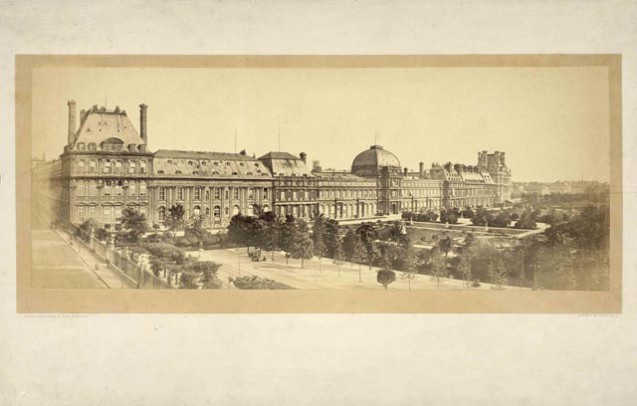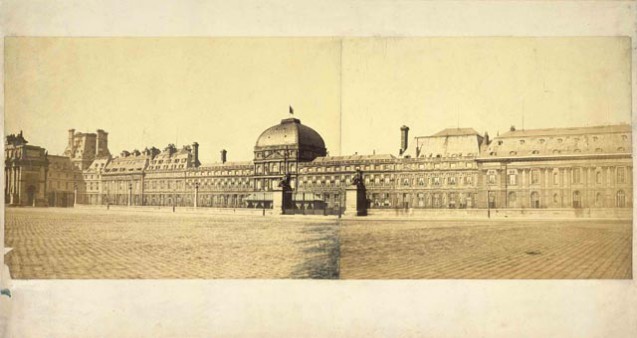

These two photographs taken by Édouard Baldus are interesting for three reasons. First, they are visual evidence for buildings that are long gone; second, they show the last phase of work on the Louvre; and third, they reveal the advances in photographic technique used by the photographer.
As for the joining of the Palais du Louvre to the Palais des Tuileries, it was not just a 19th-century whim. The idea had been floated as long ago as the reign of Henri IV. This colossal undertaking, generally referred to as “le Grand Dessein” (the Great Design), was a challenge given to some of the greatest architects, namely, Bernini (famous for his Fontana dei Quattro Fiumi in Rome), Mansart (the renowned architect of the Château de Maisons-Laffitte), and Percier and Fontaine (celebrated for their interior at the Château de Malmaison).
During the Second Empire, Napoleon III appointed the architect Louis Visconti to oversee a project called “Les Nouvelles Tuileries” (‘The New Tuileries’). The area was cleared very quickly, and the first stone was laid on 25 July 1852. For these building works, Visconti was helped, and later replaced following his death in 1853, by the architect Hector Lefuel. The structure was completed in 1857, but it would be a few years before all of the interior fittings and decorations were completed.
Between 1855 and 1858, Hector Lefuel commissioned the Prussian painter and photographer Édouard Baldus to take pictures of the construction site. These two photographs date from this commission. Baldus was highly regarded by the society of the Second Empire and was known in particular for giving his shots of buildings a painterly feel. His works played a significant role in the ennobling of the young art of photography.
These two photographs, which both belong to the Fondation Napoleon, are of the part where the Louvre façade joins that of the Tuileries, seen from both sides: the first shows the garden side of the château from the Pavillon de Marsan to the Pavillon de Flore (INV 1167.1), whilst the second displays the courtyard side from the Aile de Marsan (Marsan Wing) to the Pavillon de Flore (INV 1167.2). In the centre of both photographs the entrance to the palace, the Pavillon de l’Horloge (Clock Pavilion), dominates. Here visitors would climb the Grand Staircase built by Percier and Fontaine to reach the different floors and wings; indeed it was the only way to reach the auditorium in the Aile de Marsan. In the courtyard view, the Arc de Triomphe du Carrousel is visible on the left.
Baldus’ photographic campaign is both a working tool for the architect and an archive presenting the history of the building at a particular moment in time. Indeed, this joining of the Palais des Tuileries to the Palais du Louvre was to be photographed from every angle: from small details of ornamentation to panoramic views. Indeed, in compiling his panoramas, Baldus set about creating a good number of montages (i.e., images composed of more than one photograph). The photo showing the courtyard side of the Tuileries from the Aile de Marsan (Marsan Wing) to the Pavillon de Flore (INV 1167.2) illustrates this procedure clearly. A vertical line close to the Pavillon de l’Horloge shows the join between two images, and shadows have been added to the cobblestones to make the light in the two photos match. On the other hand, the view of the garden side of the château from the Pavillon de Marsan to the Pavillon de Flore (INV 1167.1) is a single photograph (not a montage) taken with a new camera designed especially for the taking of panoramas created by Koch and Wilz.
In the end, the celebrated junction of the two palaces was only to last a mere ten years. In 1871, a three-day inferno gutted the Tuileries. After the shell of the palace was demolished in 1872, several architects, including Hector Lefuel, proposed reconstruction projects, but to no avail. These two photographs, which remained in the Baldus family archives until their purchase by the Fondation Napoléon in 2002, thus provide a moving testimony to a building that, over the centuries, had always fascinated French sovereigns.
Elodie Lefort (manager of the Fondation Napoléon Collection)
May 2018 (English translation JS with PH)
These two photographs can be seen in the exhibition “Art in the Service of Power. Napoleon I-Napoleon III“, in Rueil-Malmaison (outside Paris) until 9 July 2018.
Discover the Fondation Napoléon Collection, its exhibitions, masterpieces, and the general online catalogue…

